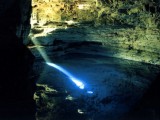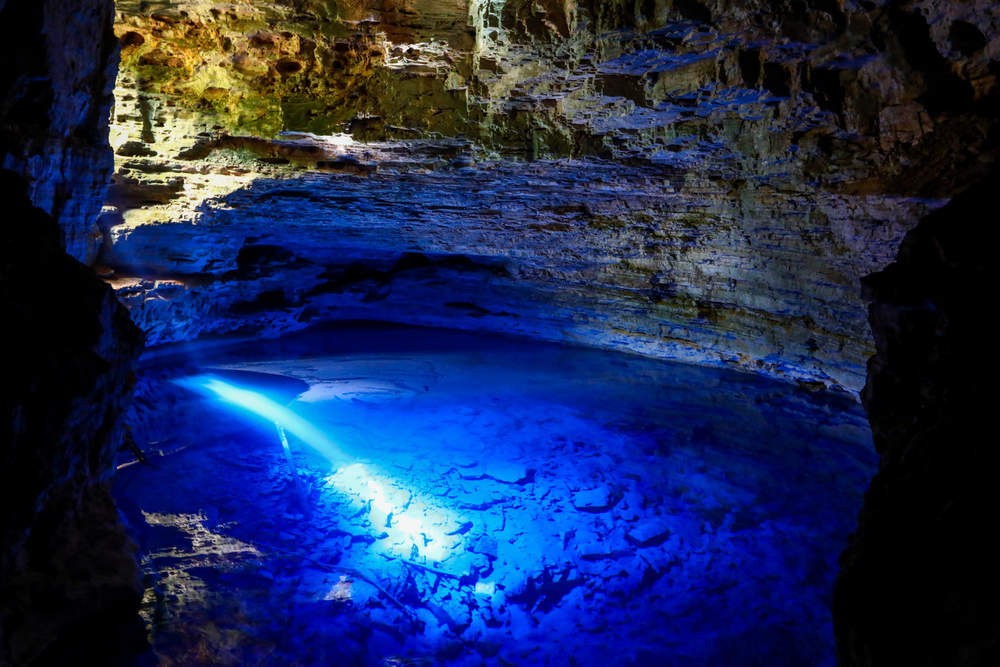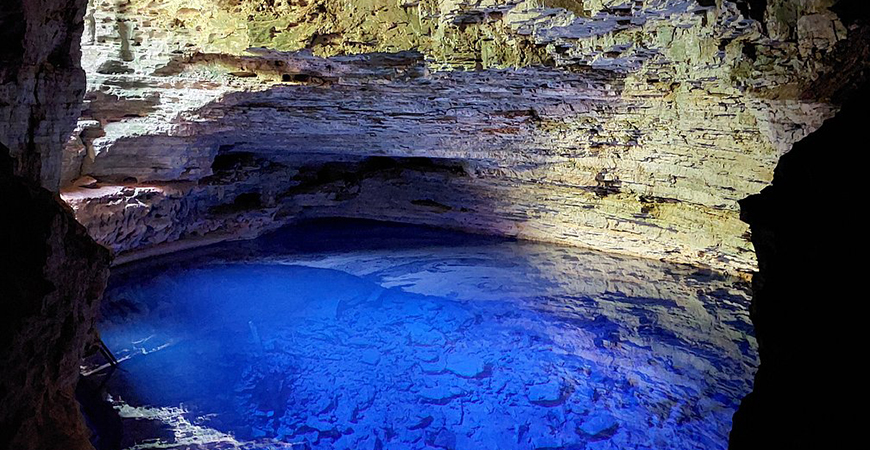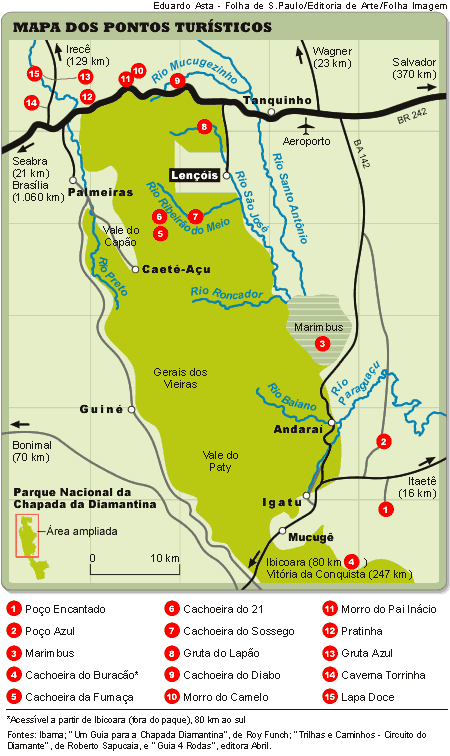Este post também está disponível em:
Português
English

The Poço Encantado is a spectacle of nature all year round, especially in winter, when a ray of sunlight falls on the surface of the well through an opening at the top of the cave and illuminates it, making its waters even bluer. It’s an impressive phenomenon (150 km from Lençóis).
Knowing where the rock ends and the water begins is a disturbing but unavoidable exercise when visiting the Enchanted Well.
Not even its 65-meter depth can hide the rocks and fallen logs at the bottom of this extremely crystalline lagoon.
The magic of its intense, transparent blue color is due to the purity of the water. But it is the sun’s rays that enter the well through a natural skylight that are the main spectacle. As it passes over the rock, the sun enchants by illuminating the water.
As with any show, there is a set date and time for the show.
In winter, the sun reaches the ideal position to enter the well. That’s why the best time to visit is from April to September, from 9.30am to 2pm. June and July (from 10am to 12pm) are the months when the lightning is most intense.
As well as changing and intensifying the color of the lagoon, the sun’s rays transform the well into a mirror on which images of the ceiling are projected. To know which is which, pay attention to the difference in tone. The dark blue part corresponds to the bottom of the lagoon and the lighter part to the reflection of the ceiling.
From December to February (from 10:30 p.m. to 2 a.m.) the sun gives way to the moon. On full moon nights, a silver beam invades the well.
Map of the Trails and Tourist Spots of Chapada Diamantina
110 meters long and 70 meters wide, the lagoon is inhabited by a very rare fish: the albino catfish.
Blind, the albino catfish is guided by its three antennae. With an average length of 4.5 cm, the fish feeds on debris found in the cave – organic matter, bat droppings and insects. A similar species has already been found in other Brazilian caves: the Poço Azul (Nova Redenção-BA), the Lapa Doce (Iraquara-BA) and those located in Petar (São Paulo-SP).
Watch the video about Igatu, Poço Azul and Poço Encantado


Igatu, Poço Azul e Poço Encantado

Poço Encantado na Chapada Diamantina03:58

Poço Encantado - Chapada Diamantina - Saiba Tudo25:49
Poço Encantado (Enchanted Well) in Chapada Diamantina
1. Origin
Formed by limestone rock, the well’s cave was excavated by the movement of water from an underground river.
As the water level decreased over the years, the highest part of the galleries dried up and part of the ceiling collapsed, forming a sinkhole.
Today, this passage serves as access to the Encantado well.
Until 1990, bathing was allowed in the well, but as the water circulation is slow, dives were forbidden to avoid the accumulation of sunscreen and sweat.
2. History
Legend has it that the Enchanted Well was discovered in 1940 by a boy called Gustavo. When he saw a crack in the rock while hunting, he thought it was a jaguar’s den.
Later, he returned to the crevice with his friends and climbed down with a rope. When he reached the bottom, he threw down a stone and discovered that what looked like sand was actually a calcareous cream beneath which was an extremely blue well.
The cave is listed by Ibama (Brazilian Institute for the Environment and Renewable Natural Resources).
3. Location and how to get there
The Enchanted Well is in Itaité (44 km southeast of Andaraí). To get there, take the BA-142 for 20 km to the road to Itaité. A sign indicates the entrance to the well, which is about 17 km from this point.
Poço Encantado is located outside the Chapada Diamantina National Park, on private property.
Although it is very common to take the tour from Lençóis, the town is far from the attraction and the journey will be very tiring.
The ideal option is to take an overnight trip closer to Itaetê, where the Poço Encantado is located.
For tourists in their own car, good accommodation options are Mucugê and Igatu. The tour to Poço Encantado is usually combined with a visit to Poço Azul, which has a similar light phenomenon and allows tourists to float in the water.
As the visit to the well is usually very crowded, it’s best to arrive early so as not to miss the entrance to the radius.
Access to the Enchanted Well is of medium difficulty. After descending a long staircase to the mouth of the cave, visitors face a steep section where they have to walk slowly holding onto ropes.
The guides light the way with lamps, but head flashlights are welcome.
Municipality of Itaetê in Bahia
The origins of the town of Itaetê date back to around the end of the 19th century, from a small settlement called Tamanduá on the banks of the Paraguaçu River. In the early years of the last century, a branch of the railroad was built to Tamanduá, a fact that gradually developed the town, but it was the muleteers who made Itaetê an important commercial center as a support point for troops coming from various locations in the high sertão and from the diamond mines to the railway station.
The municipality of Itaetê was created by Law No. 1,497 of September 25, 1961, signed by the Governor of the time, Juracy Magalhães. The municipality was established on April 7, 1963, when the 1st Chamber of Councillors and the 1st Mayor, Mr. Valdemar Ferraro, were sworn in. The territory of the new municipality was dismembered from Andaraí.
The name Itaetê is of Tupy-Guarani origin and means “Hard Stone”.
Located in the Chapada Diamantina Meridional Micro-Region
From Salvador on the BR 324 to Feira de Santana – BR 116 and BR 245 just before the town of Milagres, passing through Iaçú and Marcionílio Souza or on the BR 242 Itaberaba, then Iaçú, Marcionílio Souza, or on the BR 242 to the BA 142 passing through Andaraí.
Bahia.ws is the largest travel and tourism guide for Bahia and Salvador.
Chapada Diamantina Tourism and Travel Guide




















